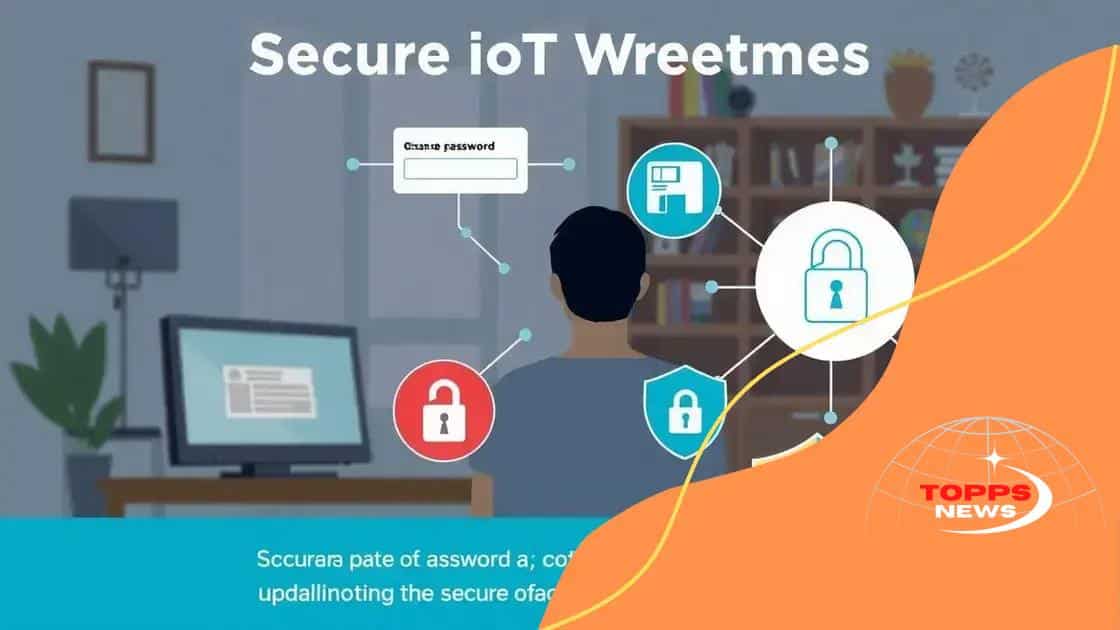Cybersecurity threats in IoT devices: what you need to know

Cybersecurity threats in IoT devices include malware, DDoS attacks, and unauthorized access, highlighting the need for strong security measures such as regular updates, secure passwords, and compliance with emerging regulations.
Cybersecurity threats in IoT devices are more pervasive than ever. With our homes becoming smarter, have you thought about what risks lurk behind those convenient gadgets? In this article, we’ll explore key threats and how to safeguard your devices.
Understanding IoT device vulnerabilities
Understanding IoT device vulnerabilities is crucial in today’s tech-driven world. As we embrace smart devices in our homes and workplaces, it’s essential to recognize the potential risks they carry. Vulnerabilities in these devices can expose sensitive data and allow cybercriminals easy access to networks.
Common Types of Vulnerabilities
IoT devices often have weak security protocols, which can lead to various issues. Here are some primary types of vulnerabilities:
- Default passwords that are often not changed.
- Inadequate data encryption, leaving data exposed.
- Outdated software that lacks essential security updates.
This lack of protection makes IoT devices prime targets for attacks. For instance, devices may collect data about user habits but do so without proper security measures. This information can be misused if in the wrong hands.
Reasons for Vulnerabilities
There are several reasons why vulnerabilities exist in IoT devices. Manufacturers often prioritize functionality over security to get products to market quickly. This decision can lead to poor coding practices or insufficient testing. Additionally, many devices lack robust user interfaces, making it hard for users to apply the necessary security settings.
Another significant issue is that many devices connect to the internet without adequate firewalls. This connection allows attackers to exploit the devices without much difficulty. Furthermore, many users are unaware of the risks associated with unsecured devices, making them less likely to take preventive measures.
Overall, addressing these vulnerabilities is essential for protecting both individual users and broader systems. By understanding the risk factors and taking proactive steps, we can help secure our IoT environments against potential threats.
Common cybersecurity threats in IoT
Common cybersecurity threats in IoT devices are becoming increasingly prevalent as more people adopt smart technology. These threats can significantly impact user privacy and security, making awareness crucial.
Types of Threats
There are several key types of threats that target IoT devices. Understanding these can help users protect themselves. Some common threats include:
- Malware: Malicious software can exploit vulnerabilities in IoT devices, leading to data breaches.
- DDoS attacks: Distributed denial-of-service attacks can overwhelm devices, causing them to crash.
- Man-in-the-middle attacks: This involves intercepting communications between devices, leading to unauthorized data access.
Each of these threats poses unique challenges. For instance, if a smart camera gets infected with malware, it could allow an attacker to access home surveillance footage. This highlights the importance of implementing strong security measures.
Impact on Users
The impact of these threats can be devastating. Not only can personal information be exposed, but devices can also be manipulated to cause physical harm. Imagine a smart thermostat being hacked, leading to dangerously high temperatures in a home. Such scenarios emphasize the need for vigilance.
Additionally, many users may not realize that their devices are compromised until it’s too late. Regular updates and monitoring are essential to stay ahead of these threats. Moreover, educating users about potential risks can significantly reduce the chances of falling victim to cyber attacks.
By staying informed and taking practical steps, users can enhance the security of their IoT devices. Implementing security protocols and being aware of common threats can protect both individual users and their connected environments.
Best practices for securing IoT devices

Best practices for securing IoT devices are essential to protect personal data and ensure the safety of connected environments. As these devices become more integrated into our daily lives, understanding effective security measures is crucial.
1. Change Default Passwords
One of the simplest ways to enhance security is to change default passwords. Many devices come with generic passwords that are easy for attackers to guess. Ensure you create strong, unique passwords that combine letters, numbers, and symbols.
2. Regular Software Updates
Updating the software on your IoT devices is vital. Manufacturers often release updates to patch vulnerabilities. Neglecting these updates can leave your devices exposed to threats. Enable automatic updates whenever possible to ensure you are always protected.
3. Use Secure Networks
Make sure to connect your IoT devices to secure networks. Avoid using public Wi-Fi for these gadgets as they can lead to unauthorized access. Instead, use a secure private network, and consider setting up a separate network just for your smart devices.
4. Enable Two-Factor Authentication
Wherever feasible, enable two-factor authentication (2FA) on your IoT devices. 2FA adds an extra layer of security by requiring a second form of identification beyond just a password. This makes it significantly harder for hackers to gain unauthorized access.
Additionally, always review the privacy settings of your devices. Customize these settings to limit the data collected and shared. Educating yourself about the specific features and settings of each device can greatly enhance your overall security.
Implementing these best practices allows you to create a more secure IOT environment. By recognizing the potential risks and proactively addressing them, you can enjoy the benefits of smart technology without compromising your safety.
Regulatory landscape for IoT security
The regulatory landscape for IoT security is evolving rapidly as smart devices become an integral part of our daily lives. Governments and organizations are recognizing the need for stringent rules to protect consumers and ensure device safety.
Key Regulations and Standards
Several well-known regulations guide the security of IoT devices. These include the General Data Protection Regulation (GDPR) in Europe and the Internet of Things Cybersecurity Improvement Act in the United States. Both regulations establish guidelines aimed at enhancing security and protecting user privacy. Understanding these regulations helps companies comply with legal standards and fosters consumer trust.
Why Regulations Matter
Having clear regulations in place is essential. They set expectations for manufacturers regarding the security standards of their devices. Consumers can feel safer knowing that companies are accountable for protecting their data. Non-compliance can lead to severe penalties, motivating businesses to prioritize security in their design and manufacturing processes.
Future Trends in Regulation
As IoT technology continues to grow, new regulations will likely emerge. Governments may adapt existing laws or create new ones to address specific challenges related to IoT security. Trends indicate a move towards more comprehensive frameworks that include guidelines for secure software development and user training. It is crucial for developers and businesses to stay updated with these changes.
In addition to government regulations, industry standards are also important. Organizations like the Internet Engineering Task Force (IETF) and the Institute of Electrical and Electronics Engineers (IEEE) are developing protocols and best practices to enhance IoT security. By adhering to these standards, manufacturers can create devices that meet consumer expectations for security.
In summary, the regulatory landscape for IoT security is becoming more complex but also more robust. By understanding and complying with these regulations, businesses can better protect their customers and contribute to a safer connected environment.
Future trends in IoT cybersecurity
Future trends in IoT cybersecurity are shaping how we will secure our smart devices as technology progresses. The increasing interconnectivity of devices introduces new vulnerabilities, making it crucial to stay ahead of potential threats.
1. Increased Use of AI and Machine Learning
Artificial Intelligence (AI) and machine learning are emerging as vital tools in cybersecurity. These technologies can analyze vast amounts of data to identify and respond to threats in real-time. For example, they can detect unusual patterns that signify an attack, allowing for quicker intervention.
2. Enhanced Device Authentication
As the landscape evolves, we can expect to see more robust device authentication methods. Multi-factor authentication (MFA) will become standard for IoT devices, ensuring that only authorized users can access and control them. This added layer of security helps protect against unauthorized access.
3. Focus on Data Privacy Regulations
With growing concerns about privacy, regulators are likely to enforce stricter data protection laws concerning IoT devices. Manufacturers may need to comply with more comprehensive standards around data encryption and user consent to safeguard user information effectively.
4. The Rise of Edge Computing
Edge computing is another trend that holds promise for enhancing IoT security. By processing data closer to where it is generated, potential threats can be identified and mitigated before they reach central servers. This reduces the risk of data breaches and speeds up response times.
As these trends develop, organizations will need to prioritize security measures when designing and deploying IoT devices. Staying informed about upcoming technologies and practices will be essential for maintaining a secure environment for users and their data. Preparing for these changes will help consumers enjoy the benefits of IoT devices while minimizing risks.
FAQ – Frequently Asked Questions about IoT Cybersecurity
What are common cybersecurity threats for IoT devices?
Common threats include malware infections, DDoS attacks, and man-in-the-middle attacks, each targeting vulnerabilities in connected devices.
How can I secure my IoT devices effectively?
You can secure your devices by changing default passwords, enabling two-factor authentication, regularly updating software, and using secure networks.
Why is it important to stay updated on IoT regulations?
Staying informed on regulations ensures compliance with data protection laws and helps manufacturers prioritize consumer privacy and security.
What future trends should I watch for in IoT security?
Upcoming trends include increased use of AI for threat detection, enhanced device authentication methods, and a focus on edge computing for data protection.





